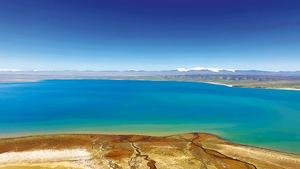 This undated photo shows a bird's-eye view of the Zhuonai Lake in Qinghai province. (PHOTO PROVIDED TO CHINA DAILY)
This undated photo shows a bird's-eye view of the Zhuonai Lake in Qinghai province. (PHOTO PROVIDED TO CHINA DAILY)
BEIJING - Chinese scientists and their international counterparts have recently discovered that China's lakes have become bluer and greener in recent decades because of reasons that include higher temperatures and rainfall.
Optically active substances in lake water can interact with sunlight, such as light absorption and scattering, making lakes show different colors. Previous studies have mapped the variations in lake colors in China, but their changing patterns and relevant reasons over the past decades remain unclear.
According to the study published recently in the journal Geophysical Research Letters, the colors for 68 percent of the lakes from 1984 to 2021 shifted toward shorter visual wavelengths. The blue lakes in western China became bluer, while the green-yellow lakes in eastern China shifted to greener colors
Researchers from Nanjing Institute of Geography and Limnology under the Chinese Academy of Sciences and other institutions in China, as well as those from the United States and Estonia, used satellite images to track annual trends of colors of more than 2,500 lakes in China since the 1980s.
According to the study published recently in the journal Geophysical Research Letters, the colors for 68 percent of the lakes from 1984 to 2021 shifted toward shorter visual wavelengths. The blue lakes in western China, such as the Qinghai-Tibet Plateau, became bluer, while the green-yellow lakes in eastern China shifted to greener colors.
READ MORE: Environmental progress made, but tough road remains ahead
The researchers also revealed the reasons behind such color changes. Most of the lakes on the Qinghai-Tibet Plateau are deep, and their water colors are mainly blue. Their colors turning bluer in the past 40 years are mainly related to lake expansion and increased transparency caused by climate warming and humidification.
 In this undated photo, a boat carrying tourists on Lugu Lake in Yunnan province's Lijiang ancient town. (PHOTO PROVIDED TO CHINA DAILY)
In this undated photo, a boat carrying tourists on Lugu Lake in Yunnan province's Lijiang ancient town. (PHOTO PROVIDED TO CHINA DAILY)
In eastern China, lakes are mainly shallow and their colors are green or yellow. The decrease in wind speed in most areas in the past 40 years has weakened the sediment resuspension, while the increase of vegetation in the basin reduces the particulate matter entering the lake. They both have made the lakes turn greener.
ALSO READ: China's largest freshwater lake sees rising water level
The findings can help to understand the changes in lake colors and their responses to climate change and human activities, according to the study.


